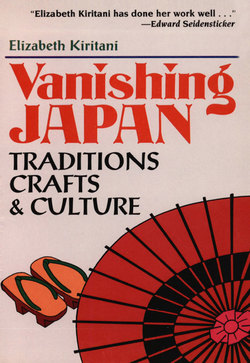Читать книгу Vanishing Japan - Elizabeth Kiritani - Страница 17
На сайте Литреса книга снята с продажи.
ОглавлениеInterior Woodworkers
The realm of the tateguya is architectural openings: windows, doors, and the like. Until the medieval ages their work was done by regular carpenters, but by the seventeenth century, the independent tateguya had come into being. At this time stores, brothels, and restaurants had increased the demand for fancy woodwork. Due to strict Edo anti-luxury regulations, though, the real tategu renaissance came after the Meiji Restoration (1868).
The advent of aluminum doors and windows pulled the rug out from under the Maejimas' traditional profession. After the war they had been too busy to relax, except for the months of January and February when cold and ice prevent them from working on lacquered wood. A major part of the lives of Masaji Maejima and his younger brother Yasuji has been dedicated to making amado, glass and shoji wooden frames, itado, and ranma, items which many are totally unfamiliar with today.
The amado, or rain shutter, dating from the sixteenth century, is a traditional type of wooden storm window—often hidden in a design panel on the outside of a house—that is slid closed during storms and at night for protection. Some modern homes use aluminum equivalents that slide out from aluminum sheds on either side of a window. The precursors of shoji, or translucent paper sliding screens, were tsuitate shoji: stand-up movable screens that were first used in temples to separate spaces in large rooms during the Nara Period (710-94). By the Heian Period (794-1185), they and other forms called ita shoji, which consisted of wooden frames with paper or cloth pasted on them; akari shoji, or light shoji, with paper or silk on a lattice; and fusuma shoji with two layers of paper had come into use. Akari shoji allowed diffused light to enter the home, and their soft moonlight inspired an orgy of poetic descriptions. This is the same type of shoji that is still used today, although current shoji are "plain Janes" when compared to the fancy pictorial lattice designs of the past. Sliding wooden doors, itado, are unique to Japan. Other countries that have used sliding doors have suspended them from above; none has run them from top and bottom as in Japan. Ranma, the fancy wooden partition designs hung from the ceilings between rooms, provided ventilation as well as decoration.
Masaji and Yasuji Maejima, both dressed in gray pants and jackets, work in a huge workshop beneath Masaji's second-story living quarters in Tsukishima, an old island community in Tokyo Bay. There are large machines along the periphery and one entire wall is hung with wooden-handled tools, the majority of which are planes of all sizes. An old potbellied stove squats near the doors, unused. Other than this, wooden shavings and stacks of spruce and other woods, the room is an open space. It's the end of March, a chilly rainy day. As the brothers talk in their mild, quiet tones, large puffs of breath evaporate in midair.
They are ambivalent about progress. The new machines are great—manual planing had been back-breaking. Yet, before, customers had made more special orders and were particular about the woods to be used. Many would come to select wood personally. Also, handmade products have a particular sheen that cannot be reproduced by machine. Now that most things are ordered by large construction companies and sizes are uniform, about half of their business involves working as wholesalers of factory-made units. Special orders are falling off, but there are more than enough orders for ready-made doors and windows. So their work is now easier and more lucrative.
A third-generation tateguya, Masaji was trained before the war from the age of fifteen and worked every day from morning to night except on the first and fifteenth of the month, his days off. After the war, their working time (previously about eleven hours a day) was stretched to fourteen hours because they were so busy. Even after aluminum windows first came into use in the early 1960s the Maejimas were constantly busy because the variety of door and window sizes required their custom services. But once measurements became standardized, special factories took over.
What about the fourth generation? Both Masaji and Yasuji smile bashfully. Of Masaji's three sons, one is a technician, one sells fish at Tsukiji, and the youngest works for Fuji-Xerox. Yasuji's son is a draftsman of government bonds. Shoulders are shrugged. There's a perfectly good business selling pre-made materials, but the skill and finesse of their profession are rarely called into practice these days. Both are adamant, though, that although changes in their business are fine by them, the old two-story wooden homes—the product of their traditional work—offer a far better lifestyle than that of the new buildings that are fast destroying the old neighborhood of Tsukishima.
